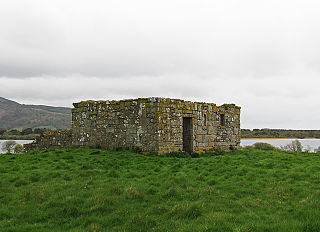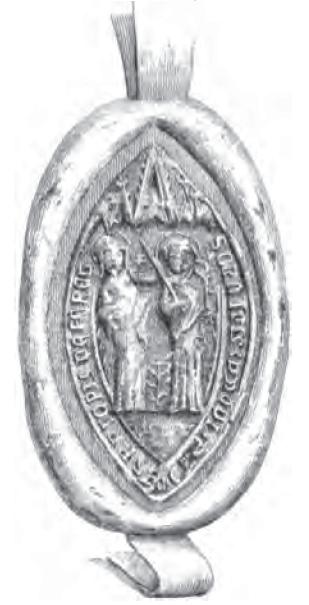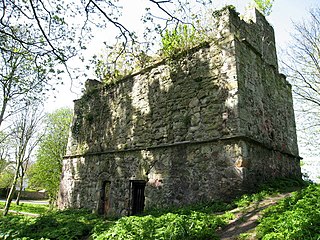Túathal is the ninth Bishop of St Andrews. He is mentioned in the bishop-list of the later medieval historian Walter Bower as the successor of Bishop Máel Dúin. Túathal's name, like his immediate predecessor Máel Dúin's, is known from other sources. A charter preserved in the Registrum of the Priory of St. Andrews, although probably translated into Latin from Gaelic at a later date, records a grant of the lands and church of Scoonie by Bishop Túathal (Tuadal) of St. Andrews to the Céli Dé of Loch Leven. Bower says that Túathal ruled as bishop for four years; as his successor Máel Dúin is known to have died in 1055, this would put his episcopate at roughly between the years 1055/6 and 1059/60. Túathal's immediate successor was the famous Bishop Fothad II.

The Abbot of Scone, before 1163 x 4, Prior of Scone, and then by the beginning of the 16th century, the Commendator of Scone, was the head of the community of Augustinian canons of Scone Abbey and their lands. The priory was established by King Alaxandair mac Maíl Choluim sometime between 1114 and 1120, and was elevated to the status of an abbey in 1163 or 1164. The abbey was turned into a secular lordship for William Ruthven, 1st Earl of Gowrie in 1581, but was forfeited when the earl was executed in 1584, given to William Foularton in the same year, but restored to the earl's son, James Ruthven, 2nd Earl of Gowrie. An independent secular lordship was established for David Murray in 1608.
The Prior of St Andrews was the head of the property and community of Augustinian canons of St Andrews Cathedral Priory, St Andrews, Fife, Scotland. It was established by King David I in 1140 with canons from Nostell Priory, West Yorkshire. It is possible that, initially at least, the prior of St Andrews was subordinate to the bishop as abbot, but by the 13th century the canons of St Andrews were given freedom by the bishop to elect their prior. By the end of the 13th century, the abbacy of the native canons was no longer there to challenge the position of the priory, and the native canons themselves had been formed into a collegiate church.
The Prior of Loch Leven was the head of lands and of the community Augustinian canons of St Serf's Inch Priory, Loch Leven. There was a Scottish Céli Dé establishment there in the first half of the 12th century, allegedly found by Bruide, son of Dargart, King of the Picts (696–706). When the Augustinian priory was founded in 1150, the Scottish monks were absorbed into the established and those who refused to join were to be expelled. Not all of the priors are known. The most famous prior undoubtedly was the chronicler, Andrew de Wyntoun. Following more than four centuries of Augustinian monastic life and the resignation of the last prior, the Protestant king, James VI of Scotland, granted the priory to St Leonard's College, St Andrews.

The St Serf's Inch Priory was a community of Augustinian canons based, initially at least, on St Serf's Inch in Loch Leven, Perth and Kinross, Scotland.
The Prior of May then Prior of Pittenweem was the religious superior of the Benedictine monks of Isle of May Priory, which later moved to the mainland became called Pittenweem Priory. The priory was originally based on the Isle of May, but was moved by 1318 to its nearby mainland site of Pittenweem, Fife, passing from the overlordship of Reading Abbey (Benedictine) to St Andrews Cathedral Priory (Augustinian). The following is a list of priors and commendators:
Clement was a 13th-century Dominican friar who was the first member of the Dominican Order in Britain and Ireland to become a bishop. In 1233, he was selected to lead the ailing diocese of Dunblane in Scotland, and faced a struggle to bring the bishopric of Dunblane to financial viability. This involved many negotiations with the powerful religious institutions and secular authorities which had acquired control of the revenue that would normally have been the entitlement of Clement's bishopric. The negotiations proved difficult, forcing Clement to visit the papal court in Rome. While not achieving all of his aims, Clement succeeded in saving the bishopric from relocation to Inchaffray Abbey. He also regained enough revenue to begin work on the new Dunblane Cathedral.
Donald Elmslie Robertson Watt FRSE was a Scottish historian and Professor Emeritus at St Andrews University.
The Prior of Pluscarden was the head of the monastic community and lands of Pluscarden Priory, Moray, Scotland. The Priory was founded in 1230 by King Alexander II of Scotland for the Valliscaulian Order. In March 1454 it incorporated the foundering neighbouring establishment of Urquhart Priory and became a dependency of Dunfermline Abbey, whence it became Benedictine. The following are a list of abbots and commendators:

Radulf was a 13th-century Scoto-Norman Cistercian monk and abbot. Most details about Radulf's career and all details about his early life are not known. His earliest certain occurrence in history is his appearance as Abbot of Kinloss in a Melrose charter datable to between 1202 and 1207. It is not known for certain when he became abbot of Kinloss Abbey, but the last known abbot of Kinloss, also called Radulf, left Kinloss in 1194 to become abbot of Melrose, putting Radulf II's succession somewhere between 1194 and 1207. Written in the margins next to Radulf's obituary is the assertion that he was the 4th Abbot of Kinloss, and if these are accurate, Radulf II would have succeeded not long after Radulf I's departure to Melrose Abbey in 1194.
Odo Ydonc was a 13th-century Premonstratensian prelate. The first recorded appearance of Odo was when he witnessed a charter by Donnchadh, Earl of Carrick, on 21 July 1225. In this document he is already Abbot of Dercongal, incidentally the first Abbot of Dercongal to appear on record.

Perth Charterhouse or Perth Priory, known in Latin as Domus Vallis Virtutis, was a monastic house of Carthusian monks based at Perth, Scotland. It was the only Carthusian house ever to be established in the Kingdom of Scotland, and one of the last non-mendicant houses to be founded in the kingdom. The traditional founding date of the house is 1429. Formal suppression of the house came in 1569, though this was not actualised until 1602.
Jonathan was a churchman and prelate active in late twelfth- and early thirteenth century Strathearn, in the Kingdom of Scotland. He was the Bishop of Dunblane during the time of Gille Brigte of Strathearn, and it was during Jonathan's episcopate that Gille Brigte founded an Augustinian priory at Inchaffray.
The Chronica Gentis Scotorum or Chronicles of the Scottish People was the first substantial work of Scottish history. It was written by John of Fordun, a priest of the diocese of St. Andrews and chaplain of the church of Aberdeen. Before his death, he had finished the first five books down to the reign of David I (1124–53) and had arranged his remaining materials, the last of which was dated 1385.

James Haldenston or James Haldenstoun was an Augustinian churchman from 15th-century Scotland. Probably from somewhere in eastern Fife, Haldenston became an Augustinian at St Andrews, earned several degrees on the continent, and became prior of May before becoming prior of St Andrews, head of the wealthiest and most important religious house in Scotland.

Robert I or Robert of Nostell was a 12th-century Anglo-Norman Augustinian churchman, the first prior of St Andrews.

St. Mary's Priory, North Berwick, was a monastery of nuns in medieval East Lothian, Scotland. Founded by Donnchad I, Earl of Fife around 1150, the priory lasted for more than four centuries, declining and disappearing after the Scottish Reformation. It had been endowed by the Earls of Carrick as well as the Earls of Fife, but over time lost its dependence on these and came to be controlled by the more locally based Home family, who eventually acquired the priory's lands as a free barony.
Walter I was a 12th-century Augustinian Anglo-Norman prelate active in the kingdom of Scotland.
Gilbert was a 12th-century Augustinian canon. Active in Scotland, he may have been of Anglo-Norman origin.
Thomas was an Augustinian canon and Cistercian monk in 13th-century Scotland. According to Walter Bower Thomas was sub-prior of St Andrews Cathedral Priory when he became prior of St Andrews, sometime in 1199. He appears as prior in contemporary documents for the first time on 6 June 1199.






